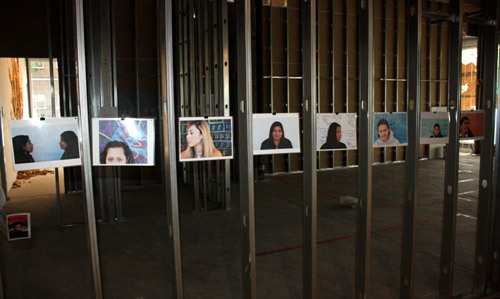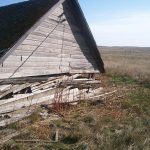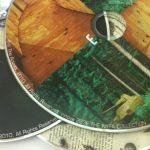Con Edison Immigrant Artist Program Newsletter: Issue No. 16
Featured Organization: Art for Chance (AfC)
This month, the IAP features Art for Change (AfC), an organization that encourages the advancement of progressive social change by using art as a catalyst for disseminating information to people. They provide space to discuss and explore that information, stimulating individual and collective reflection, which leads to action and change. The IAP is among AfC’s collaborators in their current exhibition “Gateway: An Artistic Response to the Immigration Crisis,” which runs through September 30th. IAP Program Officer Karen Demavivas interviews one of AfC’s founders Eliana Godoy.
IAP: Art for Change was founded in 1997 and your were among its founders; can you share your perspective on how it got started?
EG: I moved to East Harlem at a point in my life when I was reflecting on my role on this earth. I wasn’t happy working for a for profit company that did not connect me to a community and did not contribute towards the improvement of anything or anyone else other than other for profit companies. But, discovering the neighborhood of East Harlem and New York City made me realize that after migrating to the United States, I had never been comfortable here. I started to ponder on issues of structural violence, poverty and racism. It was evident that issues of poverty affected the US just as much as it affected my country, Bolivia. The community of East Harlem was experiencing its own transition engendered by “economic development” and gentrification. Though some people felt things were improving, I often wondered “for whom.” It seemed to me that the majority was marginalized by the effects of so-called economic development. East Harlem was also welcoming a high influx of immigrants from Central and South America, who were clearly helping to build the community yet were affected by poverty, prejudice and exploitation. I became obsessed with these issues as for me, it was all personal. As an immigrant and as a woman of color, I experienced all sorts of oppressive structures here in the US. I also experienced family violence and structural violence back home in Bolivia. Through it all, poetry, theater and dance were always my powerful tools of resistance. These artistic disciplines educated me and allowed me to digest my environment, to dissect my experiences, but most importantly to have a voice and to give voice to my people. Art became my method for coping with life’s hardships and for enjoying life’s beauty. Art gave me hope. It was this that I wanted to share with others in my new community of East Harlem. The result of this reflective period of my life is Art for Change.
IAP: Can you talk about the cultural diversity that thrives in your neighborhood of El Barrio, East Harlem and how AfC reaches out to the people who live there?
EG: East Harlem is a diverse community, home to African Americans, Puerto Ricans and immigrants from Central and South America. There is also the presence of immigrants from China and Africa. Art for Change interacts with the community through it diverse programming such as youth theater (CALLE), family workshops, and exhibits (Art Belongs to Everyone). It also interacts with artists and volunteers living in East Harlem. Artists can not only promote their work, but they can also interact with their community. Much of our work has focused on providing a platform where people can congregate in a safe environment to engage in the exploration of social and political issues. Though we strive to build bridges among the many diverse identities of our neighborhood, a few of our programs target the immigrant population. As a collaborative of immigrants and children of immigrants, we at Art for Change are devoted to providing support to the immigrants of East Harlem and to assist in the analysis of the complexities of immigration.
IAP: AfC has also carried out an international exchange project in Bolivia. Can you share what it was about, how it came about and the reactions of the Bolivian community the project engaged?
EG: The project ExplorArte was in many ways a natural evolution for Art for Change. First, it activated many of our core volunteer educators, youth workers and artist educators by providing a collaborative and participatory program where leadership development and youth empowerment played key roles. Second, it allowed us to deepen our understanding of our collective model. Third, it provided us with the opportunity to connect our local community to an international community. Fourth, it allowed us to develop a more sophisticated structure and programmatic design. The program’s objectives were to facilitate youth empowerment workshops where young people would have the opportunity to 1) engage in analysis of their current environment; 2) engage in active civic engagement; 3) develop leadership skills, 4) strengthen collaborative work through cultural exchange and 5) create art work to voice their social, cultural and political experiences.
ExplorArte was a transformative experience for everyone involved both in the US and in Bolivia. The young people in Bolivia thought Art for Change would bring Euro-American “experts” to tell them what to do and how to do it (top-down strategies often used in international development). They were amazed to meet a diverse group of young artists and facilitators interested in a non-hierarchical and participatory approach. Young people in Bolivia were so empowered that they actually started their own art collectives.
IAP: AfC is now presenting “Gateway: An Artistic Response to the Immigration Crisis,” a group exhibition showcasing works by international and national artists. Can you discuss its theme in more detail, why it was chosen and why now?
EG: “Gateway: An Artistic Response to the Immigration Crisis” is a group exhibition installed over 14,500 square feet, showcasing artworks by international and national artists Patricia Cazorla, Esperanza Cortes, Aissa H. Deebi, Roberto De Jesus, Laura F. Gibellini, Marissa A. Gutiérrez-Vicario, Alejandro Endoke Makuendo Guzman, Gabriel Pacheco, Tara Parsons, Michael Pribich, Elisa Pritzker, Gabriel Reese, Christina Stahr, The Border Project and Nancy Saleme, with a special installation by Michael Sherman. Through drawings, sculptures, and site-specific installations, artists explore historical and contemporary narratives within immigration, including: acculturation; gentrification; economic inequality; discrimination and racism; the “culture of exile” and plight of refugees; immigration policies, regulations and reform; and the controversial roles played by politicians, activist groups, and privatized media.
Art for Change decided to launch an immigration campaign at its third annual public arts festival. The goal of the campaign is to increase awareness of the plight of immigrants while redirecting the current rhetoric of criminalization. As a collective, we are very much concerned with the recent escalation of hate and anti-immigrant sentiment. We are also worried about the messages we are sending to new generations and to the negative effect criminalization and deportation have on children, who are often ignored from the conversations on immigration. We are interested in shifting the paradigm so that people gain an understanding of the complexities behind the immigration crisis and thus engage in a more critical political analysis of the situation. Today, we are faced with a nation where a majority of the people are passive spectators of some of the most racist policies of our times.
Artists trace the path of immigrants beginning with Deebi’s “Don’t You Forget About Me (Hope/Amal)” an installation of 1000 paper nightingales that embodies the inspirational journey of global migration. The relationships, dreams, hopes, and cultural values that support the voyage are given a voice within Parsons’ bed installation, “Up All Night Sleeping,” which invites viewers to express their own intimate stories. Gutiérrez-Vicario’s reconstructed container unit, “Storage” focuses on the plight of refugees and the issues of forced displacement and survival that they endure. Pritzker’s cardboard “Immigrant Suitcases” underscore the profound loss immigrants experience in leaving behind personal relationships and memory-laden objects. De Jesus’ “Main Course Cargo, [Vamos Allá]” sculpture of disposable, detergent bottle-caps highlights the commoditization in human trafficking that treats people as import / export merchandise. Pacheco’s “Shadows: Immigration, Migration and Transportation” drawings open a dialogue on the reasons that drive people to migrate and the current public policies and human rights issues that they confront globally. Pribich’s installation, “Ladder of Success,” utilizes stepladders, brass tubing and chains to honor the contributions of blue-collar street laborers as well as acknowledge the idealized and often unattainable promise within the “American Dream” and the harsh reality of immigrant workers in the US.
Collaborating artists, Cazorla and Saleme specifically address the consequences of the recent immigration laws in Arizona on migrant workers in their site-specific mixed media mural, “DeFence.” Gibellini’s site specific mural, “(In)Habitation I” explores the politics of “space” and “place” negotiating the physical and psychological aspects of acculturation built into immigrants’ daily lives through adaptation and integration. In “El Guaraguao en El Barrio,” Guzman takes on a shamanistic role, encompassing himself in a mountain of locally found objects while holding a taxidermy red tail hawk indigenous to both New York and Puerto Rico for a performance that celebrates cultural differences while underscoring our shared history and humanity. Cortes and Reese document and memorialize the priceless legacies of immigrants, specifically in East Harlem. During Hacia Afuera, Cortes interviewed and photographed elder immigrants about their experiences in “Esperanzas en el Jardin de las Esperanzas,” while Reese’s painting “American Rose” pays homage to the cyclical, cross-cultural nature and dynamic beauty of the American Barrio as a haven for immigrants, offering hope and opportunity amid alienation. Stahr welcomes visitors to walk along her “Red Tape Labyrinth” in order to reflect upon the concept of “passage,” the process of migration and states of transience. Students from The Border Project share their perspective of living in the present-day cultural and political borders of Arizona, Mexico, and the Tohono O’odham Indian Reservation.
IAP: Are the artists in the exhibition coming from an immigrant experience themselves or involved in activism among immigrant communities?
EG: There are more than fifteen local and international artists participating in the exhibit and the program itself. Each of them is exploring the issue of immigration from a different lens, a different process, and a different experience. Most of the artists are coming from an immigrant experience themselves and/or are engaged in solidarity work with immigrant communities. I will highlight one example from the exhibit and two from the Gateway as a larger program of the campaign. For instance, the high school participants of “The Border Project” share their perspective of living in “the present day” of the cultural and political borders of Arizona, Mexico and the Tohono O’odham Indian Reservation. This is an interesting project started by artists Morgana Wallace and Jewel Fraser Clearwater. For more information, visit http://www.theborderproject.org/index.html.
The other example is Favianna Rodriguez who is part of the program Gateway in the capacity of facilitator of a workshop “How to Design to fight Anti-Immigrant Hate.” Favianna Rodriguez is an artist-entrepreneur who has helped foster resurgence in political arts both locally and internationally. Rodriguez is renowned for her cultural media projects dealing with social issues such as war, immigration, and globalization, as well as for her leadership in establishing innovative institutions that promote and engage new audiences in the arts. In 2009, she co-founded Presente.org, a US-based, nationwide organization dedicated to the political empowerment of Latinos via the internet and mobile messaging.
The last example of an artist participating in the Gateway program is filmmaker Dr. Ray Romano who will present his film “The Other Side of Immigration.” This is an award-winning documentary based on interviews with men and women in the Mexican countryside. The film explores why so many people leave small Mexican towns to work in the United States and what happens to the families and communities they leave behind. Dr. Germano has conducted extensive research in the Mexican countryside with support from the National Science Foundation. His dissertation advances a unique theory about the billions of dollars Mexican immigrants send home every year.
IAP: AfC is also carrying out a community organizing campaign called The Ugly Side of US: Direct Action for Immigration Reform. What interventions have artists and activists in the campaign conducted so far?
EG: “The Ugly Side of US” was Art for Change’s first attempt at mobilizing artists to work on issues of immigration. In many ways, this was the first installation of the Immigration Campaign. “Hacia Afuera” and “Gateway: An Artistic Response to the Immigration Crisis” are only the continuation of this work. We envision a long-term campaign, informed by undocumented immigrants and driven by the collaborative work of the collective. The campaign is still in its early stages. The next program will take the form of a town hall meeting where undocumented residents will communicate their current experiences, struggles and hopes. We hope to mold our priorities based on this meeting, while enlisting the support of undocumented immigrants and other artists from inside and outside our community. Through the campaign, we hope to engage in a meaningful and on-going dialogue that engenders the participation of many more artists. We also hope to produce programs that provide a safe space for children affected by immigration and to voice their experiences to the larger audience.
IAP: The organization depends on the talents of its volunteers; how many volunteers are active now and what are the myriad skills they contribute to AfC? How can people get involved as volunteers?
EG:There are about 25 active volunteers who come from different ethnic, educational, social and professional backgrounds. Art for Change provides ample opportunities for citizens (at various stages in their social justice trajectory and with no prior knowledge of arts programming) to become actively involved in the affairs of their community, while also facilitating learning and leadership development. Our horizontal leadership development model prepares people to take an active role in social justice even after their involvement with AFC. One of our goals is to inspire and develop life-long changemakers. All the programs of AFC are created and executed by a body of volunteers from different fields and representing diverse identities. This helps to create an environment of peer led stimulation, learning, challenging and sharing. It also serves as a demonstration that people can transcend the borders of “isms” by working towards a common goal.
The meetings resemble something of a town meeting, following a democratic process where everyone voices their opinions and participates in decision-making. The volunteers are managed by a Founders’ Circle comprised of 15 of the most dedicated volunteers. The Founders’ Circle is accessible to all. Any volunteer can be nominated to become part of the Founders’ Circle, which works in collaboration with the Board. The Board provides fiduciary responsibility and governance while the Founders’ Circle and volunteers manage and execute the programs of the organization. The Founders’ Circle members are divided among four committees: programs, administration, finance, and development. Each committee recruits its own volunteers through our many programs.
Anyone can be a part of Art for Change. People who are interested in volunteering with Art for Change can email Alyssa Fridgen and those who are interested in working on the immigration campaign should email Junior Manon <[email protected]>.
IAP: What is AfC’s vision for the future?
EG:Our vision is to develop sustainable models for citizen led organizations to thrive in an environment that makes it difficult for grass roots organizations to exist. We want to continue to provide a stimulating space for artists, activists and citizens to create.





